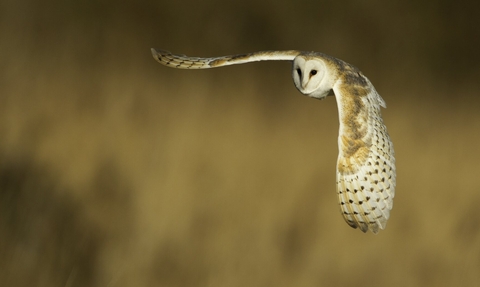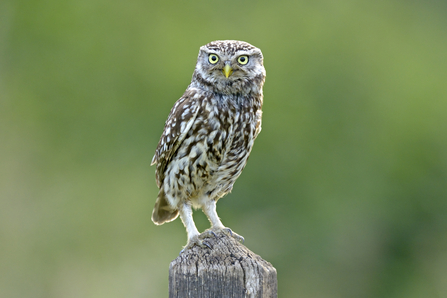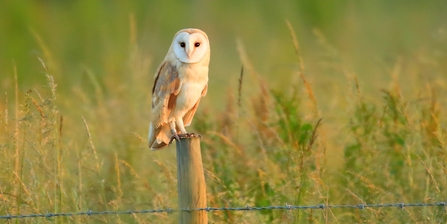
Barn Owl
Photo credit: Danny Green/2020VISION
Can you spot owls in London and take part in Owl Prowl?
Many city dwellers are unaware that owls can be found in the capital - usually in tranquil wooded areas or by open grasslands with hedgerows.
We're calling on Londoners to let us know if they hear or see any owls, to raise awareness of the city's owl populations and their conservation requirements.
Add your sightings to our Owl Prowl form
About Owl Prowl
In our original survey of 1985, 441 records were received from the public (12 for barn owl, nine for little owl, one each for short- and long-eared owl, and the rest for tawny owl).
From this data we estimated 105 pairs of tawny owl were living in London. We received records of tawny owl in Berkeley Square and Bloomsbury, a barn owl in Ealing, and little owl in Willesden Junction, and only one borough in London scored no sightings (City of London).
While Owl Prowl was in no way scientific, it did provide some baseline data. Our new survey may detect any changes in the owl populations of London, and of course raise the profile of these elusive nocturnal hunters.
Did you know many as five wild species of owl have been recorded in Greater London over recent decades? Here's more about them and how to identify them:
Tawny owl

Damian Waters / Drumimages.co.uk
The tawny owl is found in woodlands, and areas of large gardens and parks with mature trees. It appears to be increasing in numbers over recent years, with at least 11 breeding pairs recorded in 2019, including in two central London parks. It's a mostly brown, fairly compact owl with a large, rounded head, usually seen in woodland. The plumage is mottled brown but can vary from greyish to reddish-brown. The facial disk is mostly plain, with a narrow, darker wedge extending down between the large black eyes.
In-flight it shows broad, rounded wings. It has a very direct flight with quick wing beats and long, straight glides, often only flying short distances from tree to tree. Likes to hunt from perches, swooping down to prey on the ground. Largely nocturnal and rarely seen flying during the day.
The tawny owl has a rich repertoire of calls. Listen out for the short 'ke-wik' contact call and the quavering 'hoo, hu-hooo' advertising call.
Little owl

Andy Rouse/2020VISION
Little owl, a 20th-century 'newcomer', now breed in the suburban outskirts, such as Richmond Park, Brent Reservoir, and Warren Farm, although a few pairs have been found further into the city.
It's a small, compact owl with a rather flattened crown. The upper parts are dark brown with whitish streaks and spots, which are large on the back but fine on the head. There are larger whitish markings that give the impression of a false face on the back of the head. The underparts are whitish with bold brown streaks. The facial disk is greyish brown with prominent whitish ‘eyebrows’ that give it a stern expression. The eyes are yellow.
Flies with a fast, bounding flight similar to a thrush, though will take a more direct, flapping flight over short distances. Hunts by swooping down from a perch, but will also run across the ground in pursuit of prey. Most active at dawn and dusk, but can often be seen during the day.
The little owl has a variety of calls, including a fast 'chi-chi-chi' alarm call, a low-pitched hoot, and this mewling call...
Barn owl

© Jon Hawkins/Surrey Hills Photography
Barn owl, an iconic bird of traditional farmland, is hanging on as a rare breeder but can be seen hunting over some of London's more rural fringes like the Colne Valley bordering west Hillingdon, Stanmore Common, Rainham Marshes, Erith Marshes, and Beddington Farmlands. More surprisingly a pair have successfully reared young at Beckton Sewage Treatment Works over recent years. A very pale, slender owl, typically white on the underparts and golden-brown with grey markings on the upperparts. It has a white, heart-shaped facial disk with dark eyes. This, and its pale plumage, separate it from any other resident owl.
In-flight often gives the impression of a large white bird. Most often seen at dawn and dusk, though can be seen at night or even hunting during the day. Flies back and forth over fields.
The barn owl calls with eerie squeals and a shrieking 'shreeee'. Take a listen...
Long-eared owl

WildNet - Andrew Mason
Long-eared owls are scarce winter visitors and passage migrants usually found on expansive wetland reserves or in London's outer eastern marshy fringes around Dagenham and Rainham - which provide more suitable habitat. Recent sightings also include at South Harefield, Warren Farm (Hanwell) and South Norwood Country Park.
A streaky brown owl that looks very similar to a short-eared owl. It has generally darker feathers, with less of a yellow hue than the short-eared owl. The facial disk is buff with a well-defined blackish border, with white ‘eyebrows’ extending down towards the beak. The eyes are deep orange and only have a little bit of black feathering around the inner edge – it doesn’t surround the eye, as in a short-eared owl. There are long, obvious ‘ear-tufts’ on the top of the head, though these can be lowered and less conspicuous.
In-flight can be tricky to separate from the short-eared owl. Slightly shorter and more blunt-tipped wings, with fine black barring on the wingtips (compared with the solid black wingtips of short-eared owl). The dark streaking on the breast extends down over the belly, giving a darker appearance to the underside. The dark barring on the tail is finer than in a short-eared owl, and there is no white trailing edge to the upper wing.
A long-eared owl is typically a nocturnal hunter but can sometimes be seen hunting during the day, so seeing an ‘eared’ owl hunting in daylight hours doesn’t automatically make it a short-eared owl. In winter, resident birds are joined by migrants from further east. Forms communal roosts, which can be very sensitive to disturbance so should be viewed from a distance.
The male long-eared owl advertises with deep, soft hoots with no inflection, given in a regular series with a hoot every few seconds. Sometimes gives weak wing-claps as it flies over its territory. The female has a more nasal call. The begging call of chicks can be heard from a great distance: high pitched squeaks like the hinges of a rusty door.
Short-eared owl

Short-Eared Owl (Asio flammeus) stretching its wing, Worlaby Carr, Lincolnshire, UK - Danny Green/2020VISION
Short-eared owl also rarely breeds in London, first recorded at Rainham Marshes in 1986, then intermittently into the 1990s, and in 2008. There have been no records since then. It's a sandy-brown owl similar in size to a tawny owl, but with longer wings. The upper parts are mostly yellowish-brown with darker streaks, whilst the underparts are a paler yellow with dark streaks on the breast. The facial disk is a pale whitish or yellowish-brown, with a well-defined border. There are dark patches surrounding the piercing yellow eyes as if the owl were wearing a lot of black eyeshadow! The short-eared owl has short ‘ear-tufts’ on top of the head, though they are usually barely visible.
In-flight, shows long, narrow wings. Compared to the similar long-eared owl, the wings are slightly longer and more slender, with solid black wingtips – as if they have been dipped in ink. It has a streaked breast, but a pale, un-marked belly, and thick dark barring on the tail. It also shows a white trailing edge to the upper wing. Flies with slow wingbeats and wavering glides. Often hunts during the day, as well as at night. Breeds mainly on moorland, but are found more widely in winter when migrants arrive from the continent.
The short-eared owl is rarely heard away from its breeding grounds, where males sometimes perform display flights, giving a fast series of deep hoots as well as short, quick wing-claps. Other calls are rasping barks, which are given in a quick series when birds are alarmed, like this one...
Owls have always been present in London, but are rarely heard, let alone seen, by many. They have benefitted from the improved management of many of our parks, and the growing maturity of the urban forest of garden trees and railway woodlands.
Nevertheless, the loss of brownfield sites, and the loss of garden vegetation pose threats to their survival in the inner city.
We and others have been managing nature reserves for many years to benefit owls.
We hope as many people as possible will contribute to Owl Prowl. The presence of owls in London is indicative of the quality of natural habitats we have - especially woodlands, grasslands and brownfields - and if they are in decline it will highlight what measures we need to take to ensure their future survival."
Director of Conservation of London Wildlife Trust
